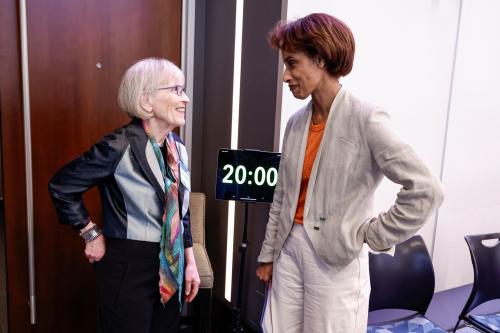This paper is part of the Summer 2020 special edition of the Brookings Papers on Economic Activity, the leading conference series and journal in economics for timely, cutting-edge research about real-world policy issues. The editors are Brookings Nonresident Senior Fellow and Northwestern University Professor of Economics Janice Eberly and Brookings Nonresident Senior Fellow and Harvard University Professor of Economics James Stock. Submit a proposal for future BPEA conferences here.
The percentage of families concerned about getting enough to eat has more than doubled during the coronavirus pandemic despite one-time federal stimulus payments and a temporary boost in unemployment benefits, estimates a paper discussed at the Brookings Papers on Economic Activity (BPEA) conference on June 25. Its authors recommend that Congress extend many of the temporary benefits it enacted in March and increase food support for the poorest families.
Overall, households worried about their food supply jumped from 8.5 percent in February to 23.0 percent on average from late April through mid-May, and food insecurity more than tripled among households with children, from 9.3 percent to 29.5 percent, according to The social safety net in the wake of COVID-19.
Its authors—Marianne Bitler of the University of California-Davis, Hilary Hoynes of the University of California-Berkeley, and Diane Schanzenbach of Northwestern University—attribute the rise in food insecurity in the face of $2 trillion in new federal spending to holes in the social safety net. Many workers, for instance, are not eligible for unemployment benefits, and administrative delays in obtaining unemployment and other temporarily enhanced benefits left some families short of food.
The authors derived their food insecurity estimates by comparing a monthly survey conducted by the Centers for Disease Control and a special weekly survey that the Census Bureau is conducting during the pandemic. They note that food insecurity rose even though enrollment in the Supplemental Nutrition Assistance Program (SNAP), formerly known as food stamps, increased nearly 20 percent through May (based on projections from the nine states that have released data). Meanwhile, Congress authorized states to pay all SNAP recipients the maximum benefit in April and May. However, SNAP recipients with the lowest incomes, who already received the maximum, received no increase. (Maximum SNAP benefits vary by family size; benefits are reduced as a family’s income increases.) The authors recommend a longer-lasting increase in SNAP benefits, including a 15 percent increase in the maximum benefit.
“Unemployment increased by more among workers with low levels of education. Families with children lost school meals. We’ve also had the biggest increase in food prices in 50 years. That’s a perfect storm,” Schanzenbach said in an interview with The Brookings Institution.
“Increasing SNAP benefits really makes sense. It both provides relief to struggling families and stimulates the economy. And we know that low-skill workers are the last to regain their jobs during a recovery, which makes me think that poverty and food insecurity will be elevated for years in the absence of a strong policy response,” she said.
“We’ve had the biggest increase in food prices in 50 years.”
Congress also authorized the Pandemic Electronic Benefits Transfer program for families with children who lost free or reduced-price school lunches. But it has been slow to roll out in many states, the authors note, leaving families with few resources in the short run.
Longer term, the authors recommend building “automatic stabilizers” for benefits into the law so that when a downturn strikes Congress does not have to pass legislation, and states do not have to apply for waivers. That would get more money into more people’s hands more quickly.
Meanwhile, a second paper—Income and poverty in the COVID-19 pandemic—found that the government’s initial response to the pandemic effectively prevented a rise in poverty. The government response included one-time Economic Impact Payments as well as expanded unemployment benefits. The impact payments provided 159 million recipients (through early June) with, in most cases, $1,200 for individuals, $2,400 for married couples, and an additional $500 for qualifying children. Congress also temporarily expanded eligibility for unemployment benefits to include the self-employed and others who do not usually qualify, added $600 a week to benefits through July, and extended the maximum duration of benefits from 26 weeks to 39 weeks.
The result, according to the paper’s authors—Jeehoon Han and Bruce D. Meyer of the University of Chicago, and James X. Sullivan of the University of Notre Dame—was that poverty declined after the start of the pandemic and incomes rose throughout the distribution of income.
The government’s official poverty estimates for 2020 will not be available until September 2021. So, the authors constructed new measures of the income distribution and income-based poverty using data from a monthly Census Bureau survey that collects information on family income from all sources during the past 12 months.
They found that incomes at the 25th percentile (meaning 25 percent earned less and 75 percent earned more) rose from about $46,000 to about $51,000, or more than 10 percent, between the start of the year and April and May. Meanwhile, the poverty rate declined from an average of 10.9 percent in January and February to 8.6 percent in April and May.
In an interview, Meyer cautioned that income and poverty will need to be monitored as the recession continues.
“In the short run, the government benefits have counteracted the sharp decline in earnings that we have seen in recent months,” he said. “But it is important to keep track of how those at the bottom are doing over the coming months, and we show how to do that.”
David Skidmore authored the summary language for this paper.
CITATION
Han, Jeehoon, Bruce D. Meyer, and James X. Sullivan. 2020. “Income and Poverty in the COVID-19 Pandemic.” Brookings Papers on Economic Activity, Summer, 85-118.
Bitler, Marianne, Hilary Hoynes, and Diane Schanzenbach. 2020. “The Social Safety Net in the Wake of COVID-19.” Brookings Papers on Economic Activity, Summer, 119-145.
CONFLICT OF INTEREST DISCLOSURE
Bitler, Hoynes, and Schanzenbach:
The authors did not receive financial support from any firm or person for this paper or from any firm or person with a financial or political interest in this paper. Co-author Marianne Bitler was paid by the California Department of Public Health for research and analysis of the WIC Program as it relates to vendors, however the analysis did not focus on WIC participation and food spending behavior because of economic shocks, but rather on how changes among vendors impacts participant shopping behavior. Hilary Hoynes is a member of the board of directors for MDRC and the California Budget and Policy Center. They are currently not officers, directors, or board members of any organization with an interest in this paper. No outside party had the right to review this paper before circulation. The views expressed in this paper are those of the authors, and do not necessarily reflect those of Northwestern University, the University of California, Berkeley, or the University of California, Davis.
Han, Meyer, and Sullivan:
The authors did not receive financial support from any firm or person for this paper or from any firm or person with a financial or political interest in this paper. They are currently not officers, directors, or board members of any organization with an interest in this paper. No outside party had the right to review this paper before circulation. The views expressed in this paper are those of the authors, and do not necessarily reflect those of the University of Chicago or the University of Notre Dame.








